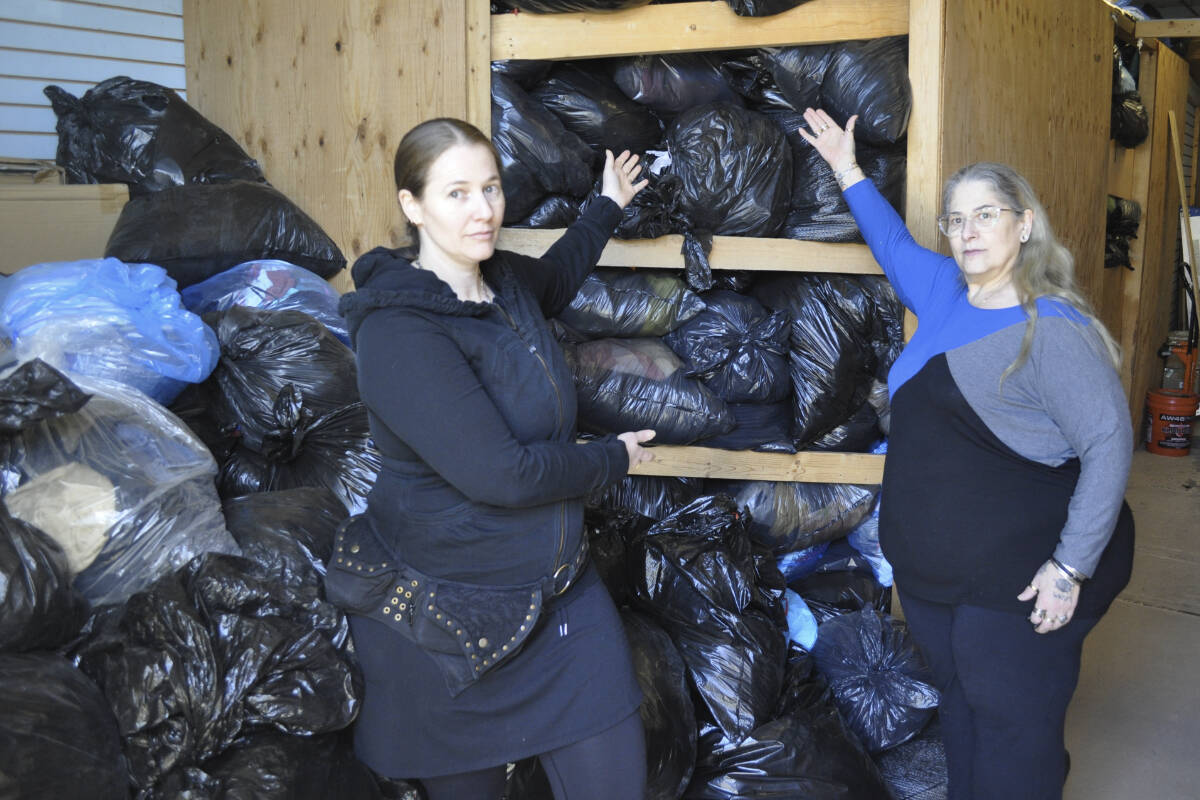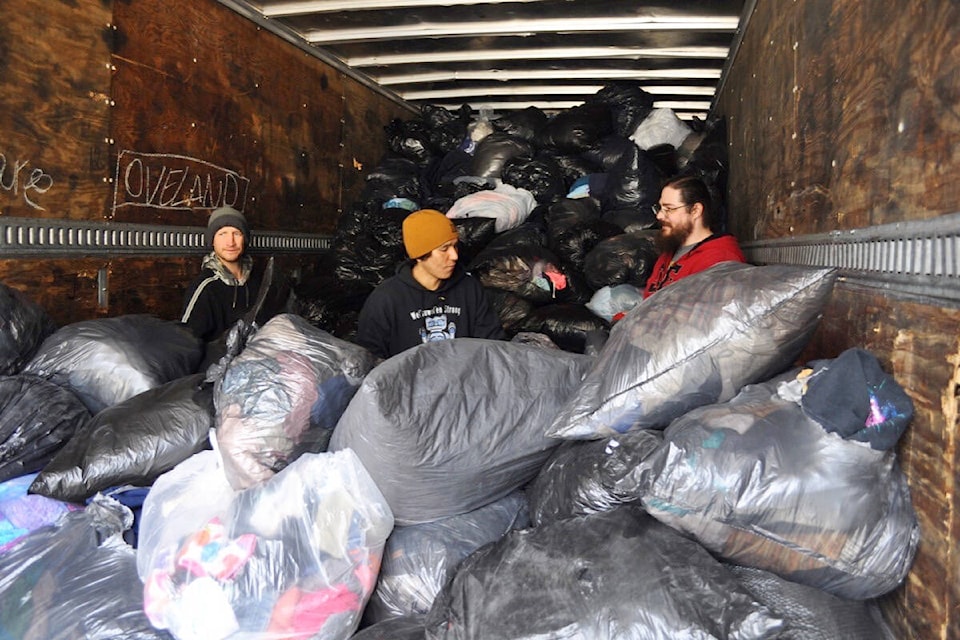Every three weeks, a crew of nine people gather outside a Nelson thrift store. They form a chain, and over several hours fill a semi-trailer to capacity with bags of clothes.
Stained shirts, pants with worn-out knees, jackets with broken zippers, the bags are packed with clothes that are either ruined in some way or have simply gone out of fashion.
Once the trailer is loaded, the clothes are sent to a recycling centre in Vancouver where they are cleaned, sorted, shipped overseas or repurposed.
Better there than a landfill according to Positive Apparel owners Simone Varey and Aviva Keely, who for over a decade have tried and failed to find a local recycling solution to the thousands of pounds of old clothing Kootenay residents no longer want.
“Look at this,” Varey says as she points at a storage room that’s overflowing with bags. “Imagine this in our dump, in our landfills.”
Over the last 13 years, Keely says Positive Apparel has diverted nearly 300,000 pounds of waste textiles from the Grohman Narrows Transfer Station located just outside Nelson.
The material is sent to the Lower Mainland, where B.C.’s only dedicated textile recycling facilities are located. The clothes are washed and sorted, then either resold, made into rags or sent overseas.
It’s a costly endeavour for Positive Apparel. The store spends approximately $5,700 monthly to rent extra storage space, pick up clothes from other thrift stores and charities throughout the West Kootenay, rent the semi-trailer and make its delivery to Vancouver. Typically they do the trip once every four weeks, or every three weeks in the summer.
The effort gives Positive Apparel first pick of clothing for its store, but the majority of material isn’t anything customers would buy. The store has historically only been paid between 10 and 15 cents per pound sent to Vancouver, and they need to make 10 trips annually to break even.
“The profit margin in this industry is tiny,” says Varey. “People think, ‘oh you get everything for free, you must make gobs of money.’”
Keely wants to see that material stay in the West Kootenay.
A decade ago, Positive Apparel set up a non-profit organization and local facility that would have repurposed textiles into stuffing for pillows and couches. Anything with natural fibres could have been used to grow mushrooms. But just three months into the endeavour a trailer carrying their stock flipped on the highway, and the ensuing costs ended their plan before it could begin.
Ideally, Keely says, a textile recycling facility would be operated by local governments. She says it could be set up for shredding, with materials used as rags, blankets, landscape cloth or for futons and upholstery.
“This is obviously a resource. We’re not using this resource at all, we’re sending this resource away.”

Keely said the store had previously approached the RDCK about expanding into textile recycling, but felt there was no interest.
That could change in the near future.
Amy Wilson, the RDCK’s resource recovery manager, was surprised to hear how much material Positive Apparel is diverting from the transfer station. She said the district’s sustainability department staff had already planned to attend a workshop later this month on circular economies, in which resources are reused locally, with textiles as a focus.
The workshop is being run by the B.C. organization Textile Lab For Circularity (TLC), which advocates for the elimination of textiles from landfills.
TLC managing director Tracy Lydiatt says clothing sent to textile recycling facilities doesn’t necessarily keep it out of landfills. Some of it is shipped overseas to secondary markets, where if it is soiled or damaged it is burned or buried in landfills.
“What happens to those materials when they’re actually processed? Some of them are ragged. Some of them are sold to foreign markets and the rest, unfortunately, I think goes to energy recovery.”
There are three obstacles to growing textile recycling in B.C., according to Lydiatt.
The first is a lack of a provincial ban on textiles in landfills. Do that, she says, and it will spark innovative solutions to textile recycling.
There’s also a lack of political funding and will to take on textile recycling. Lydiatt said she’s been told by provincial officials that the public’s focus right now is on plastics.
“We feel like textiles is hopefully simmering underneath the surface. Some optimistic folks say it’ll be two to three years and some say like [five to 10 years] before the province puts that legislation in place.”
Finally, textile recycling is a logistics problem. Shipping material to facilities is one hurdle, but right now most of the sorting work isn’t automated and is labour intensive. That’s complicated by the fact not every material is easy to recycle. A cotton shirt is easier to shred than stretchy yoga pants.
Lydiatt says she believes the public has good intentions for their clothing, which is why so much of it is donated instead of being tossed away. But that’s also part of what she calls wishcycling. People give away clothing hoping it goes to a place it will be used, without a thought for what happens next.
“The problem is they like holding on to jeans and old Gore-Tex jackets and literally have half a closet full of stuff because they know enough that they don’t want it to go to landfill. There’s also no viable solution for them yet to have it fully recycled.”
So the shirt that didn’t match what it looked like online, the jacket a child outgrew or the pants that became a little too tight end up with thrift stores like Positive Apparel.
Keely says her store will keep taking donations, but the public’s reliance on thrift stores to keep clothing out of landfills isn’t sustainable.
“Fundamentally the issue is out of sight, out of mind, which is why people donate.”
CORRECTION: A previous version of this article incorrectly stated Positive Apparel isn’t getting paid for shoes, belts and purses. The story also said the store makes trips to the Lower Mainland once every three weeks or twice in the summer. It’s actually every four weeks, or three in the summer.
READ MORE:
•
•
•
| tyler.harper@nelsonstar.com
Like us on and follow us on .



